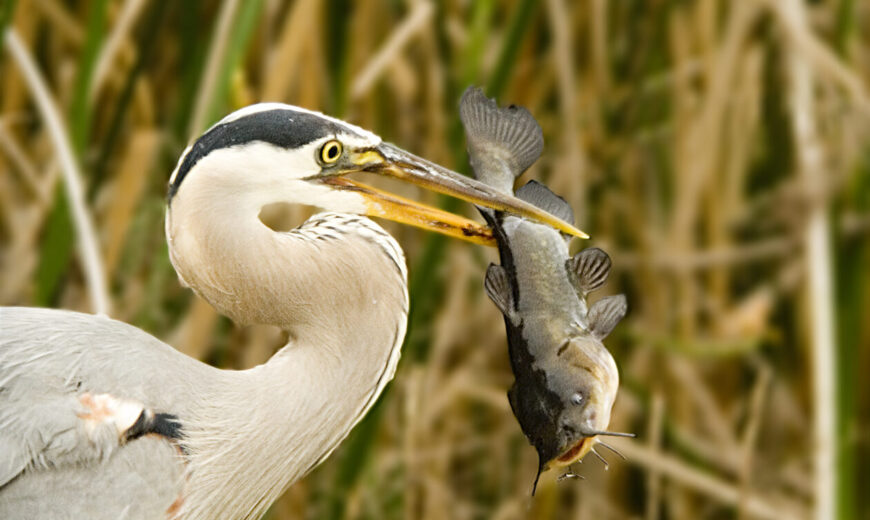Danger, yellow bullheads! Danger! The schreckstoff, or ‘scary stuff’ present in the skin cells of the fish in this heron’s bill likely saved other bullheads from a similar fate.
April 5, 2024
“Ist das nicht eine Schnitzelbank?
Ja das ist ein Schnitzelbank…”
Ach, if only I had a Funfcentstuck for every time we sang that song in German class. Never mind that it was more of a German-American creation rather than a relic from the Old Country. And traditionally sung while drinking beer-or should I say bier? Neither aspect kept us from singing Schnitzelbank week after week, following along as Herr Kurz pointed out the words…on a poster from Mader’s, the German restaurant in Milwaukee…
Like The Twelve Days of Christmas, each verse of Schnitzelbank adds a line to the verse before it, so the song gets longer and longer as it goes along. I wish we had the time and space to go through the entire piece, because lyrics like Haufen Mist (manure pile), Schnickel Fritz (naughty boy), Dicke Frau (stout woman) and Fette Sau (fat sow) just don’t get sung enough these days.
The reason I bring all this up is because I recently came across a word that’s really deserving of its own Schnitzelbank verse. There I was, contentedly reading some science news, when the term jumped out at me: Schreckstoff.
Literally translated it means fright substance, but it’s more often defined in English as scary stuff. And while this stoff, or stuff, has no effect on humans, to fish it can mean the difference between life and death.
Schreckstoff is a term coined by Austrian ethologist Karl von Frisch back in 1938. As a scientist who studies animal behavior, he’d observed that a school of minnows dispersed when a kingfisher dropped an injured pal of theirs back in the water. He later replicated the behavior with minnows in an aquarium, noting how they quickly startled, dropped low, schooled together and then fled. He theorized that when a fish sustains an injury, it releases a chemical that causes this alarm response.
He also noted “Es kann stunden- oder tagelang dauern, bis die alte Zutraulichkeit wiederkehrt.”
None of those words are in the Schnitzelbank song, but thanks to Google Translate we can interpret his observation as, “It can take hours or days for the old trust to return.”
The implications of von Frisch’s discovery have rippled through the scientific community for decades. Could a fish really be so altruistic as to warn its conspecifics once it’s been injured? What was even more puzzling was, if that fish sustained mortal injury, how in the world could it pass along the genetics that created the chemical?
Further research has provided evidence that schreckstoff might well be part of a fish’s immune system, protecting it from parasites and other pathogens, and even harmful UV rays. When a mishap causes its release, it might not save that particular individual; rather, that one fish will “take one for the team” and then those teammates-other fish in the school-sense the chemical and react accordingly. Because the many fish who sense schreckstoff survive, so too does the olfactory trait for sensing it.
I know what you’re thinking, as I had the same thought: What about catch-and-release fishing? If schreckstoff is really a thing then how come, on a good day, you can hook a smallmouth, a walleye, a bluegill, let it go, and then repeatedly catch more?
It turns out, only certain types of fish produce schreckstoff. It’s mostly been found in species within Ostariophysi, a superorder that includes minnows and carp as well as suckers and catfish, plus fish like tropical fish like tetras and piranhas. (Interestingly enough, piranhas have over time lost their ability to produce and react to schreckstoff, likely because most of their prey also are Ostariophysians. Think about it… If they bit into a juicy minnow, then received a chemical message to flee and hide, they’d quickly earn the title of World’s Worst Predators.)
Research scientists have also observed that some fish have the ability to “turn off” their schreckstoff production-though not their ability to sense it–during the breeding season. Take, for example, the male fathead minnow.
In order to entice a lady friend to mate, he must excavate substrate from beneath a horizontal surface, such as a rock or log. In so doing, there’s a good chance his skin will get scraped. If schreckstoff were then released, any females in the area would promptly leave, and his work would be for naught. But thanks to the on-off adaptation, our local waters have plenty of successful fathead nests, and plenty of fathead minnows.
Like the Schnitzelbank song, schreckstoff research has many verses, and as time goes on the discoveries continue to grow. The latest–the one that caught my eye the other day–is that researchers in Japan studied not only the alarm compounds, but also how the fishes’ brains reacted to them. It turns out, a Schreckstoffreaktion is triggered only when a fish perceives both a superorder-specific chemical that says, in essence, “Warning! Hazard ahead!” AND a species-specific compound that conveys, “This means YOU!” (Or, for 1960s sci-fi fans, “Danger, Will Robinson! Danger!”)
The implications for these findings are far reaching. As lead researcher Yoshihiro Yoshihara commented in a press release, “Conspecific odors can drive numerous behaviors, and even people are known to react to odors produced by other people. This type of biological two-factor messaging system could therefore be a common theme underlying many types of social communication through olfaction.”
There you have it folks, better understanding of life’s complexities, made possible by fish alarm chemicals.
Ist der Schreckstoff nicht wunderbar?
Ja der Schreckstoff ist wunderbar!
Pam Otto is the outreach ambassador for the St. Charles Park District. She can be reached at potto@stcparks.org.

